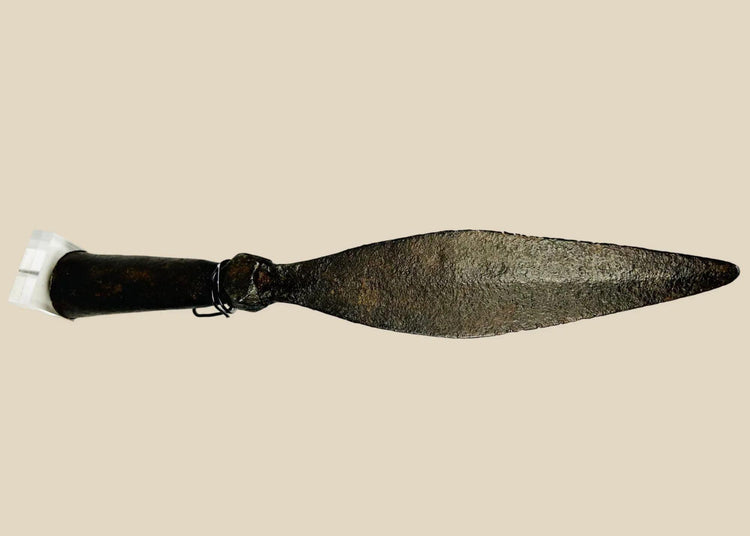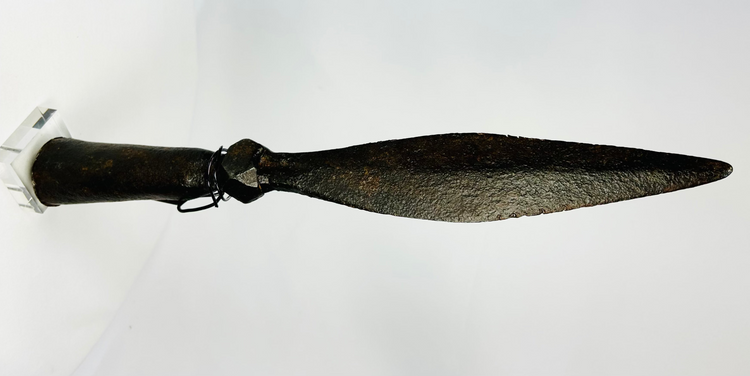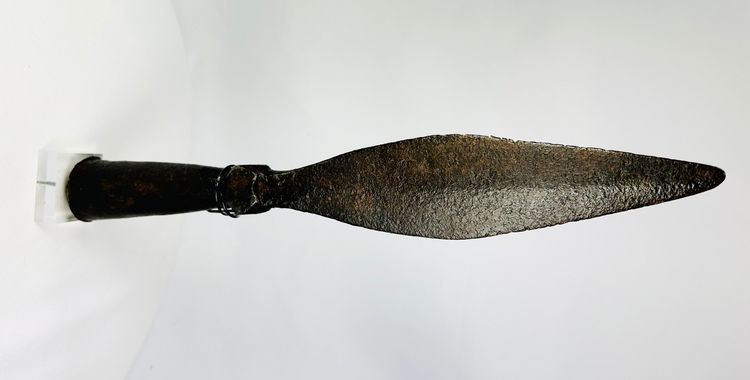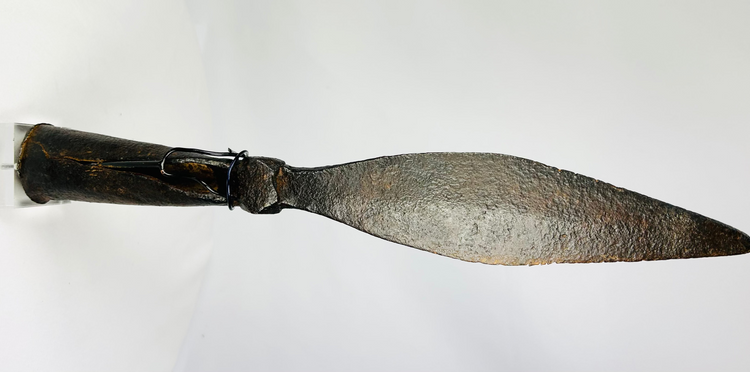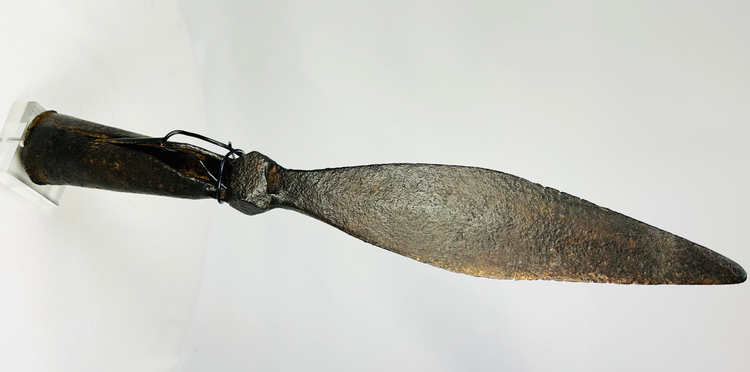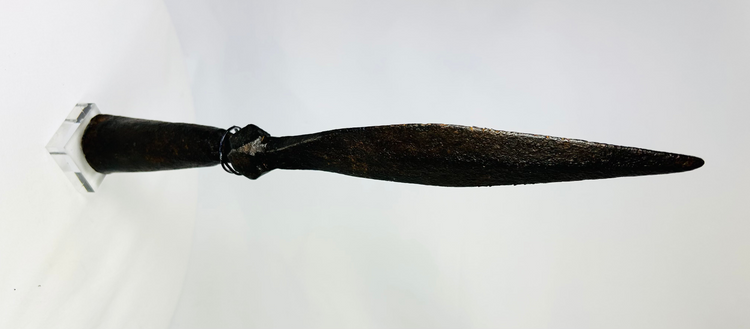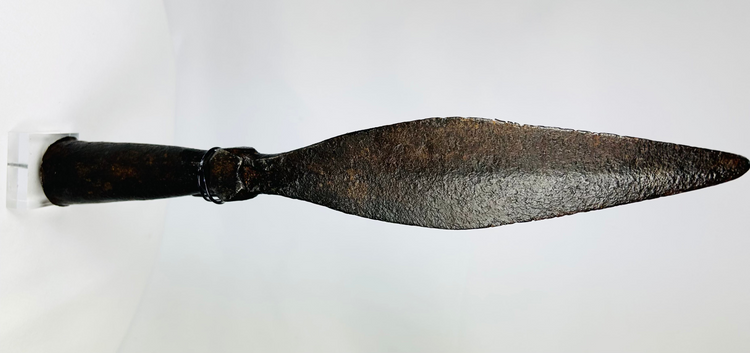Chinese Eight Banner Spear | Iron Blade with Natural Wood Shaft | Qing Dynasty | 18th Century
Description
More
Less
Historical Context & Origin
Region: China
Material: Iron with natural wood shaft
Period: Qing Dynasty, 18th century (1644–1912)
Description
This finely crafted Chinese iron spearhead, dating to the Qing Dynasty, exemplifies the martial traditions of the Manchu and Mongol troops of the elite Eight Banners army. The weapon features a broad leaf-shaped blade designed for both thrusting and cutting, with a socketed base for secure attachment to a wooden shaft. The natural wood shaft, unadorned and practical, reflects the utilitarian military focus of Eight Banner equipment, while a square “stopper” at the base of the blade provided an innovative tactical advantage by keeping enemies at bay.
Features
- Leaf-shaped iron blade for versatile combat use
- Socketed base for secure shaft attachment
- Square stopper below blade to maintain distance from opponents
- Natural wood shaft, consistent with traditional Eight Banner spears
- Rich surface patina from age and use
Cultural Significance
Spearheads such as this were essential weapons of the Eight Banners, the elite hereditary army that formed the foundation of Qing military power. Unlike the Green Standard Army, Eight Banner troops were armed with larger, more imposing spears to reinforce their dominance in the field. These weapons symbolized both martial strength and imperial control, serving in battle, garrison duty, and as emblems of the Manchu warrior tradition. The Chinese word qiāng (槍) encompassed both spear and lance, reflecting the versatility of such polearms in mounted and foot combat alike.
Condition
Excellent antique condition with well-preserved blade form, socket, and shaft. Natural patina and wear are consistent with age and authentic battlefield use.
Dimensions
Length: 12.75 in
Age
Qing Dynasty, circa 18th century
Learn More
Discover when the very first spearheads appeared — the surprising origins of humanity’s oldest weapon.
Explore Our collection of historic spearheads
Uncover the world of the Qing Dynasty through the National Museum of Asian Art — a journey into emperors, warfare, culture, and one of history’s most powerful eras.
Description
Historical Context & Origin
Region: China
Material: Iron with natural wood shaft
Period: Qing Dynasty, 18th century (1644–1912)
Description
This finely crafted Chinese iron spearhead, dating to the Qing Dynasty, exemplifies the martial traditions of the Manchu and Mongol troops of the elite Eight Banners army. The weapon features a broad leaf-shaped blade designed for both thrusting and cutting, with a socketed base for secure attachment to a wooden shaft. The natural wood shaft, unadorned and practical, reflects the utilitarian military focus of Eight Banner equipment, while a square “stopper” at the base of the blade provided an innovative tactical advantage by keeping enemies at bay.
Features
- Leaf-shaped iron blade for versatile combat use
- Socketed base for secure shaft attachment
- Square stopper below blade to maintain distance from opponents
- Natural wood shaft, consistent with traditional Eight Banner spears
- Rich surface patina from age and use
Cultural Significance
Spearheads such as this were essential weapons of the Eight Banners, the elite hereditary army that formed the foundation of Qing military power. Unlike the Green Standard Army, Eight Banner troops were armed with larger, more imposing spears to reinforce their dominance in the field. These weapons symbolized both martial strength and imperial control, serving in battle, garrison duty, and as emblems of the Manchu warrior tradition. The Chinese word qiāng (槍) encompassed both spear and lance, reflecting the versatility of such polearms in mounted and foot combat alike.
Condition
Excellent antique condition with well-preserved blade form, socket, and shaft. Natural patina and wear are consistent with age and authentic battlefield use.
Dimensions
Length: 12.75 in
Age
Qing Dynasty, circa 18th century
Learn More
Discover when the very first spearheads appeared — the surprising origins of humanity’s oldest weapon.
Explore Our collection of historic spearheads
Uncover the world of the Qing Dynasty through the National Museum of Asian Art — a journey into emperors, warfare, culture, and one of history’s most powerful eras.
You May Also Like




















